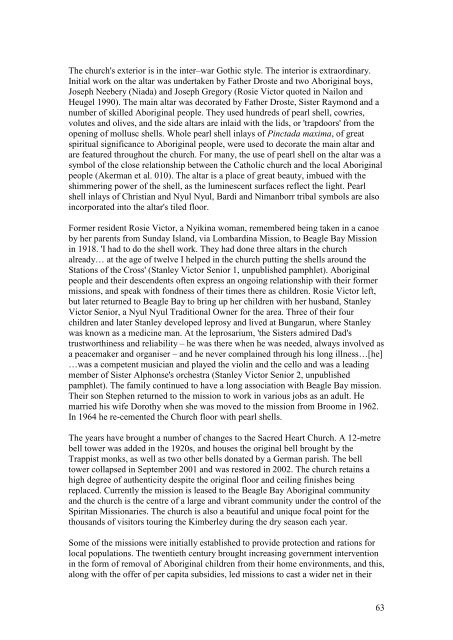WEST KIMBERLEY PLACE REPORT - Department of Sustainability ...
WEST KIMBERLEY PLACE REPORT - Department of Sustainability ...
WEST KIMBERLEY PLACE REPORT - Department of Sustainability ...
Create successful ePaper yourself
Turn your PDF publications into a flip-book with our unique Google optimized e-Paper software.
The church's exterior is in the inter–war Gothic style. The interior is extraordinary.<br />
Initial work on the altar was undertaken by Father Droste and two Aboriginal boys,<br />
Joseph Neebery (Niada) and Joseph Gregory (Rosie Victor quoted in Nailon and<br />
Heugel 1990). The main altar was decorated by Father Droste, Sister Raymond and a<br />
number <strong>of</strong> skilled Aboriginal people. They used hundreds <strong>of</strong> pearl shell, cowries,<br />
volutes and olives, and the side altars are inlaid with the lids, or 'trapdoors' from the<br />
opening <strong>of</strong> mollusc shells. Whole pearl shell inlays <strong>of</strong> Pinctada maxima, <strong>of</strong> great<br />
spiritual significance to Aboriginal people, were used to decorate the main altar and<br />
are featured throughout the church. For many, the use <strong>of</strong> pearl shell on the altar was a<br />
symbol <strong>of</strong> the close relationship between the Catholic church and the local Aboriginal<br />
people (Akerman et al. 010). The altar is a place <strong>of</strong> great beauty, imbued with the<br />
shimmering power <strong>of</strong> the shell, as the luminescent surfaces reflect the light. Pearl<br />
shell inlays <strong>of</strong> Christian and Nyul Nyul, Bardi and Nimanborr tribal symbols are also<br />
incorporated into the altar's tiled floor.<br />
Former resident Rosie Victor, a Nyikina woman, remembered being taken in a canoe<br />
by her parents from Sunday Island, via Lombardina Mission, to Beagle Bay Mission<br />
in 1918. 'I had to do the shell work. They had done three altars in the church<br />
already… at the age <strong>of</strong> twelve I helped in the church putting the shells around the<br />
Stations <strong>of</strong> the Cross' (Stanley Victor Senior 1, unpublished pamphlet). Aboriginal<br />
people and their descendents <strong>of</strong>ten express an ongoing relationship with their former<br />
missions, and speak with fondness <strong>of</strong> their times there as children. Rosie Victor left,<br />
but later returned to Beagle Bay to bring up her children with her husband, Stanley<br />
Victor Senior, a Nyul Nyul Traditional Owner for the area. Three <strong>of</strong> their four<br />
children and later Stanley developed leprosy and lived at Bungarun, where Stanley<br />
was known as a medicine man. At the leprosarium, 'the Sisters admired Dad's<br />
trustworthiness and reliability – he was there when he was needed, always involved as<br />
a peacemaker and organiser – and he never complained through his long illness…[he]<br />
…was a competent musician and played the violin and the cello and was a leading<br />
member <strong>of</strong> Sister Alphonse's orchestra (Stanley Victor Senior 2, unpublished<br />
pamphlet). The family continued to have a long association with Beagle Bay mission.<br />
Their son Stephen returned to the mission to work in various jobs as an adult. He<br />
married his wife Dorothy when she was moved to the mission from Broome in 1962.<br />
In 1964 he re-cemented the Church floor with pearl shells.<br />
The years have brought a number <strong>of</strong> changes to the Sacred Heart Church. A 12-metre<br />
bell tower was added in the 1920s, and houses the original bell brought by the<br />
Trappist monks, as well as two other bells donated by a German parish. The bell<br />
tower collapsed in September 2001 and was restored in 2002. The church retains a<br />
high degree <strong>of</strong> authenticity despite the original floor and ceiling finishes being<br />
replaced. Currently the mission is leased to the Beagle Bay Aboriginal community<br />
and the church is the centre <strong>of</strong> a large and vibrant community under the control <strong>of</strong> the<br />
Spiritan Missionaries. The church is also a beautiful and unique focal point for the<br />
thousands <strong>of</strong> visitors touring the Kimberley during the dry season each year.<br />
Some <strong>of</strong> the missions were initially established to provide protection and rations for<br />
local populations. The twentieth century brought increasing government intervention<br />
in the form <strong>of</strong> removal <strong>of</strong> Aboriginal children from their home environments, and this,<br />
along with the <strong>of</strong>fer <strong>of</strong> per capita subsidies, led missions to cast a wider net in their<br />
63
















